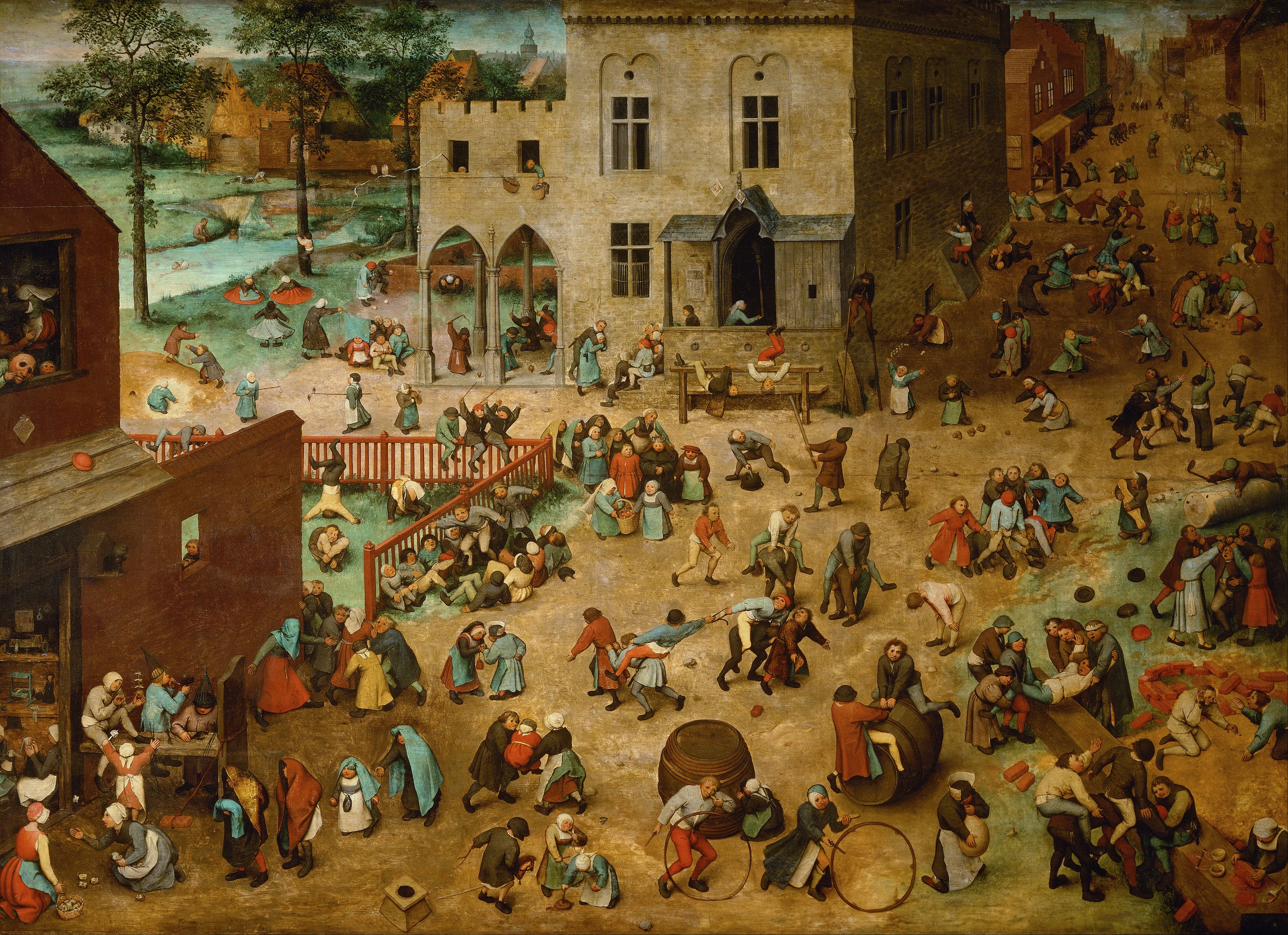Summary

Question: What did kids do before Gameboy?
Answer: Everything.
Annotations
Important works:
Nicholas Orme’s Medieval Children.
Barbara Hanawalt’s The Ties That Bound: Peasant Families in Medieval England.
Pieter Bruegel the Elder’s Children’s Games.
1/ Bringing Up Bebe, by Pamela Druckerman, is the book about how the French raise children. Achtung Baby, by Sara Zaske, is a similar book about Germany. There’s No Such Thing as Bad Weather tackles the subject from a Scandinavian point of view, and The Danish Way of Parenting will help you bring up tiny happy vikings. Battle Hymn of the Tiger Mother, by Amy Chua, is about how Asian (Asian American?) mothers push their offspring to academic success. There’s basically an endless number of these books purporting to tell parents the same secrets: how to get your kids to eat vegetables, do their homework, and occasionally let you talk to your spouse without interrupting so you don’t entirely lose your mind and sense of self. In my professional opinion, some of it works, some of it doesn’t, and whether you lose your sense of self is entirely up to you.
Jesse: The “weird” (and horrible) part is how integral colonialist and imperialist perspectives are to a lot of the views of childrearing that we are discussing at the beginning of this episode. A breathtaking sense of entitlement is required for anyone to hold the incredibly patronizing view that someone (probably a white, western woman) is “discovering” child rearing techniques used by non-western cultures (or even western cultures of which the aforementioned woman is not a part!). It doesn’t matter how many times the woman acknowledges her privilege, the whole concept is still colonialist nonsense.
Em: I looked up the chapter I’m referring to, and the writer’s claim is a bit more circumscribed–she merely suggests that births in small-group hunter-gatherer societies (which, as she describes them, are basically egalitarian utopias) are painless, relaxed, guided only by the wise elder women of the tribe, and also lead to babies that develop better moral sense than the poor babies whose mothers have things like epidurals and C-sections available. Relatedly, please, if you are ever looking at someone with a PhD and feeling intimidated, remember that there are a ton of PhD-having people who are basically idiots.
2/ Jesse: I just went to see Free Guy (with Ryan Renolds and Taika Waititi), and there is a nice discussion about the importance and fun of swings.
3/ Pet rock.
4/ A roulette wheel actually has 37, 38, or 39 spaces, depending on if you are playing the single/double/triple zero version. Please credit this podcast when you win $2 off a guy in a pub.
5/ In Terry Pratchett’s Snuff, young Sam (Commander Sam Vimes’s son) very happily collects animal poo.
6/ Hula hoops are most closely related to an Australian exercise hoop made from bamboo brought back to the US in the 1950s, but hoops have been used for various reasons throughout history, the hoop dance being only one example. Check out the Tiktok of hoop dancer James Jones for a sample.
The toy/toys mentioned in Gilgamesh is/are actually called “pukku” and “mikku.” They appear in tablet XII, which contains a story of Enkidu glimpsing the underworld, as a sort of preview of his death at the end of the poem. Nobody is entirely sure what they are (at least, per The Babylonian Gilgamesh Epic: Introduction, Critical Edition, and Cuneiform Texts, vol. 2, A. R. George, Oxford University Press, 2003, see p. 898). Based on context, a mikku is something made from a long stick, and a pukku is made from a tree trunk. So hoop and stick is a possible translation, or drum/drumstick, or any number of other things. Other poems describe people fighting battles as “clash[ing] together like pukku and mekku” or send[ing] heads rolling like heavy pukkus.” This issue comes up more than you’d think in literature, where we often have no idea what certain things that were very familiar to the authors were, just because the world has changed so much. Bill Bryson mentions a 19th century shaker that sat on Victorian tables alongside salt and pepper–no one knows what it contained.
7/ Cripple Mr Onion is actually a card game similar in some respects to poker and blackjack (summary with rules here).
8/ The Last Dance includes a famous scene of Michael Jordan playing “quarters” (the game where you toss a quarter close to–but not touching–a wall, and the closest player wins).
9/ Em: When I say “we” were prevented from playing with matches, I mean me and my siblings–Jesse, as far as we know, was a perfect child who did not try such a thing. Or didn’t get caught.
10/ The Seventh Seal contains the most famous depiction of a medieval dance line.
11/ The Manneken Pis. Brussels is super proud of this statue for some reason. [Jesse: I mean, it’s pretty cool!]
Jeanneke Pis: gender equality for the win!
12/ Relevant to our discussion of knucklebones, Jesse randomly found these dice made of actual human bones. Super weird and creepy, with possible consent issues! Not available in several states! (Em forgot to add this in while actually editing the episode, so we’ll just leave it here as a final note.)
Podcast: Play in new window | Download

